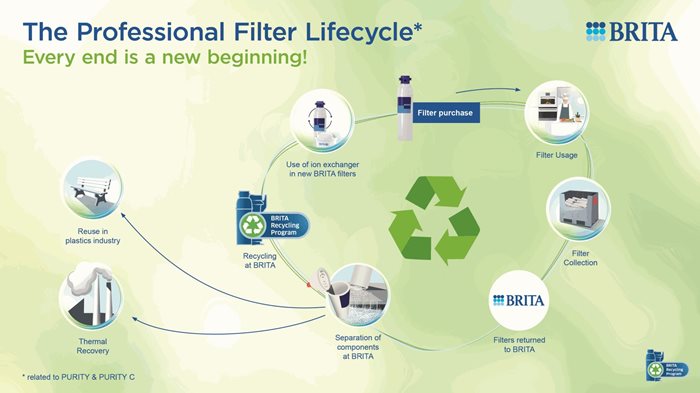Elements in water can influence your coffee’s taste, consistency and appearance. But what happens to used water filter cartridges? Which components can be recycled or repurposed to protect the environment? BRITA explains how its filter recycling programme prevents cartridges ending up in landfill
.jpg.aspx?lang=en-GB&width=700&height=430)
BRITA established a recycling programme for its cartridges back in 1992 – the first of its kind in the industry | Photo credit: BRITA
Water filters play a pivotal role in brewing first-rate coffee. Every cup is, after all, some 98% water. By filtering water, baristas can change its composition, tailor it to customers’ needs, and achieve the properties that make it ideal for brewing coffee.
Eventually, however, even the most durable filter cartridge will become exhausted and will need to be replaced. So, what happens next to the components?
One thing is for certain: They do not have to end up in a landfill.
The filter recycling programme
BRITA established a recycling programme for its cartridges back in 1992 – the first of its kind in the industry. The programme is based on BRITA’s own recycling plant in Taunusstein, Germany. Ultimately, the majority of parts can be recycled, either internally at BRITA or externally by partners.
The goals are to avoid waste and to minimise the cartridges’ environmental impact, by reusing and repurposing components wherever possible – to the benefit of the environment, and us all.
How it works – the first steps of the process
The first step in bringing cartridges back into the material life cycle is, quite simply, to collect them.
This is where baristas can help: Instead of disposing of the filters, they can gather them, e.g., in parcels or on pallets, or drop them off in the boxes at BRITA collection points.
The exact process varies from country to country. In the UK alone, for example, there are over 1,900 collection points.
Back in Taunusstein, the second step is to separate the components.

The first step in bringing cartridges back into the material life cycle is to collect them | Photo credit: BRITA
The filter cartridge components
BRITA Professional’s filters include the ion-exchange resin, activated carbon, and a particle filter fleece inside the plastic cartridge.
Each of these materials must be processed separately. At BRITA’s regeneration plant, the filter cartridges are opened, and the activated carbon and ion-exchange resin beads removed.
Most of the plastic parts are made of a blend of polypropylene and fibreglass; the container and the sieve can be ground down to create feedstock for new products, such as buckets.
The exhausted ion-exchangers resin can be regenerated in-house at BRITA. In 2021 alone, 1.9 million litres of resin were revived and used in PURITY and PURITY C units. The recovered material has all the properties and the same high quality of entirely new resin.
The carbon is returned to BRITA’s original supplier. They then reactivate the carbon and reuse it.
Finally, a small volume of materials is currently unrecyclable. These components are incinerated to produce heat. The energy recovered from this process can then be utilised in place of conventional fossil fuels.
Part of a broader, greener mindset
Now, more than ever, it is vital to prioritise the reuse of materials, to avoid waste wherever possible, and to choose high-quality recycling over other forms of disposal.
These efforts can help make a difference.
For more information visit: brita.co.uk